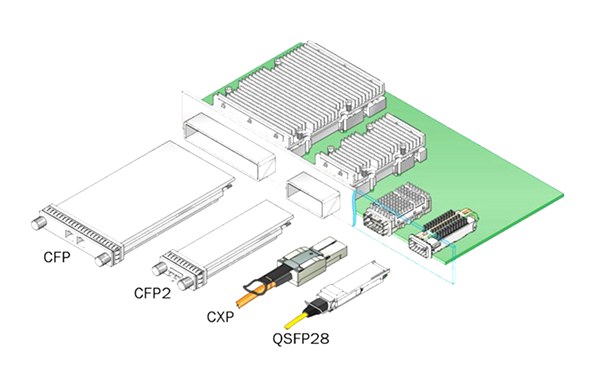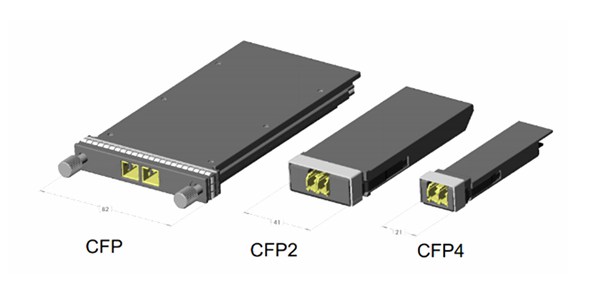The Knowledge about 100G Optical Transceivers You Should Know
2017-10-12
With the growing demand for bandwidth from fast-growing cloud services and data centers, 100G networks are growing rapidly. Ovum reported that by 2021, 100 gigabit (100G) Ethernet transceivers would exceed 15 million (Figure 1).As an important part of the 100G network, 100G optical transceivers are becoming more and more popular. At the same time, the cost of the associated component fiber (PSM4) and a large number of components (including PSM4 and CWDM4) are reduced, and the 100G optical transceiver is becoming more and more popular. What are the types of 100G optical transceiver modules? What agreements do they follow? How should the correct 100G optical transceiver module be selected? This blog will introduce 100G optical transceiver related knowledge, hope to help you.

100G Transceiver Standards
Since the advent of the 100G network, IEEE, multi-source Protocol (MSA) and so on proposed a variety of standards for the 100G optical transceiver. In these standards, the PSM4 and CWDM4 standards developed by MSA industry organizations are more suitable for 100G QSFP28 optical transceivers in the market. The following table shows the details of the 100G optical transceiver standard.
The 100G PSM4 uses 8 parallel fibers (4 send and 4 receivers), each sending 25Gbps (Figure 2). 100G PSM4 is a single mode parallel 4-channel optical transceiver, which is mainly applied to 500m scene in the data center. It provides low-cost solutions for long distance data center optical interconnects and services for parallel single mode infrastructures. and CWDM4 (Fig. 3), contrary to PSM4, uses the retrocession multiplexer to reduce the number of optical fibers to 2, and the CWDM4 MSA goal is to run a generic specification of up to 2 kilometers of low-cost 100G optical interfaces in data center applications.
100G Transceivers Types
According to different form factors, 100G transceivers can be usually divided into CFP, CFP2, CFP4, CXP, and QSFP28 Among them, CFP, CFP2, CFP4, and CXP are the early form of 100G optical transceiver, but QSFP28 is the newest version of 100G Optical transceiver, because of its lower power consumption and higher density, it has become the mainstream form of 100G optical transceiver. Like 40G QSFP + with 4 x 10Gbps channels, 100G QSFP28 is implemented with 4 x 25Gbps channels.
• CFP, CFP2, CFP2 optical transceiver
CFP Multi-source agreement (MSA) defines the requirements for hot-swappable transceivers to be applied to 40G and 100G network transmissions, including next-generation high-speed Ethernet (40GbE and 100GbE). The CFP optical transceiver supports the transmission of multiple rates, protocols and link lengths on Single-mode and multimode fibers, including all physical media-related (PMD) interfaces included in the IEEE 802.3BA Standard. There are three types of 100G networks: 100GBASE-SR10 100m, 100GBASE-LR4 10km, 100GBASE-ER4 40km.
The CFP optical transceiver is designed on the basis of a small pluggable optical module (SFP) interface, which is larger in size and supports 100Gbps data transmission. The electrical interface used by the CFP optical transceiver transmits in each direction (RX, TX) using the 10 x 10Gbps Channel. The CFP optical transceiver can support a single 100G signal, OTU4, one or more 40G signals, OTU3 or STM-256/OC-768.
Although the CFP optical transceiver can achieve 100G data transmission, its large size does not meet the needs of high-density data centers. Thus, the CFP-MSA Commission has defined two other forms: CFP2 and CFP4 optical transceivers. The following figure compares the dimensions of the CFP, CFP2, and CFP4 optical transceivers:


100G Transceiver Standards
Since the advent of the 100G network, IEEE, multi-source Protocol (MSA) and so on proposed a variety of standards for the 100G optical transceiver. In these standards, the PSM4 and CWDM4 standards developed by MSA industry organizations are more suitable for 100G QSFP28 optical transceivers in the market. The following table shows the details of the 100G optical transceiver standard.
| Standard | Group | Media Type | Distance | Date |
| 100GBASE-SR10 | IEEE 802.3ba | 24-core MPO, parallel multi-mode fiber, 10 receivers and 10 transmitters, 850nm | 100m @OM3, 150m @ OM4 | June 2010 |
| 100GBASE-SR4 | IEEE 802.3bm | 12-core MPO, parallel multi-mode fiber, 4 receivers and 4 transmitters, 850nm | 100m @ OM4 | March 2015 |
| 100GBASE-LR4 | IEEE 802.3ba | Duplex LC, single-mode fiber, 1310nm, 4 x 25G WDM | 10km @ Single Mode Fiber | June 2010 |
| 100GBASE-ER4 | IEEE 802.3ba | 12-core MPO, parallel multi-mode fiber, 4 receivers and 4 transmitters, 850nm | 40km @ Single Mode Fiber | June 2010 |
| 100G PSM4 | 100G PSM4 MSA | 12-core MPO, parallel multi-mode fiber, 4 receivers and 4 transmitters, 1310nm | 500m @ Single Mode Fiber | September 2014 |
| 100G CWDM4 | CWDM MSA | Duplex LC, single-mode fiber, 1271-1310nm, 4 x 25G CWDM | 2km @ Single Mode Fiber | August 2014 |
| 100G SWDM4 | SWDM Industry Alliance | Duplex LC, multi-mode fiber, 850-950nm, 4 x 25G SWDM | OM3, TBD WBMMF, 4TBD |
March 2017 |
| 100G CLR4 | 100G CLR4 Industry Alliance | Duplex LC, single-mode fiber, 1271-1310nm, 4 x 25G CWDM | 2km @ Single Mode Fiber |
The 100G PSM4 uses 8 parallel fibers (4 send and 4 receivers), each sending 25Gbps (Figure 2). 100G PSM4 is a single mode parallel 4-channel optical transceiver, which is mainly applied to 500m scene in the data center. It provides low-cost solutions for long distance data center optical interconnects and services for parallel single mode infrastructures. and CWDM4 (Fig. 3), contrary to PSM4, uses the retrocession multiplexer to reduce the number of optical fibers to 2, and the CWDM4 MSA goal is to run a generic specification of up to 2 kilometers of low-cost 100G optical interfaces in data center applications.
100G Transceivers Types
According to different form factors, 100G transceivers can be usually divided into CFP, CFP2, CFP4, CXP, and QSFP28 Among them, CFP, CFP2, CFP4, and CXP are the early form of 100G optical transceiver, but QSFP28 is the newest version of 100G Optical transceiver, because of its lower power consumption and higher density, it has become the mainstream form of 100G optical transceiver. Like 40G QSFP + with 4 x 10Gbps channels, 100G QSFP28 is implemented with 4 x 25Gbps channels.
• CFP, CFP2, CFP2 optical transceiver
CFP Multi-source agreement (MSA) defines the requirements for hot-swappable transceivers to be applied to 40G and 100G network transmissions, including next-generation high-speed Ethernet (40GbE and 100GbE). The CFP optical transceiver supports the transmission of multiple rates, protocols and link lengths on Single-mode and multimode fibers, including all physical media-related (PMD) interfaces included in the IEEE 802.3BA Standard. There are three types of 100G networks: 100GBASE-SR10 100m, 100GBASE-LR4 10km, 100GBASE-ER4 40km.
The CFP optical transceiver is designed on the basis of a small pluggable optical module (SFP) interface, which is larger in size and supports 100Gbps data transmission. The electrical interface used by the CFP optical transceiver transmits in each direction (RX, TX) using the 10 x 10Gbps Channel. The CFP optical transceiver can support a single 100G signal, OTU4, one or more 40G signals, OTU3 or STM-256/OC-768.
Although the CFP optical transceiver can achieve 100G data transmission, its large size does not meet the needs of high-density data centers. Thus, the CFP-MSA Commission has defined two other forms: CFP2 and CFP4 optical transceivers. The following figure compares the dimensions of the CFP, CFP2, and CFP4 optical transceivers:

RECENT BLOG POST
-
012019-10With the continuous development of 5G communication technology, 100G modules are gradually becoming popular. We know that there are many kinds of packages for 100G optical modules. From 2000 to now, the optical module package types have been rapidly developed. Its main package types are: GBIC, SFP, XENPAK, SNAP12, X2, XFP, SFP+, QSFP/QSFP+, CFP, CXP. In the fast-developing network era, some 100G optical modules avoid the risk of being eliminated, and upgraded and revised with the wave of the Internet, such as 100G CFP optical modules.
-
012019-101. What is the CWDM SFP? The CWDM optical module is an optical module using CWDM technology to implement the connection between the existing network device and the CWDM multiplexer/demultiplexer. When used with a CWDM multiplexer/demultiplexer, CWDM optical modules can increase network capacity by transmitting multiple data channels with separate optical wavelengths (1270 nm to 1610 nm) on the same single fiber.
-
012019-10AOC is the abbreviation of Active Optical Cables, which is called Active Optical Cables in Chinese. AOC active optical is to encapsulate two optical modules and cable together. Because the medium of transmission in the middle is optical cable, AOC optical module, which contains laser devices, has a higher price for DAC. However, its optical aperture is not exposed, it has high reliability, and its working distance can be customized for a long distance of less than 100 meters.
-
012019-10Dense Wavelength Division Multiplexing (DWDM) technology is capable of transmitting data in an optical fiber using bit wavelength parallel transmission or string line transmission using the wavelength of the laser.It is widely used in different fields of communication networks, including long-distance backbone networks, metropolitan area networks (MANs), residential access networks, and local area networks (LANs).The DWDM optical module is the optical module that uses this technology, so the DWDM optical module has high bandwidth and long-distance transmission characteristics.












